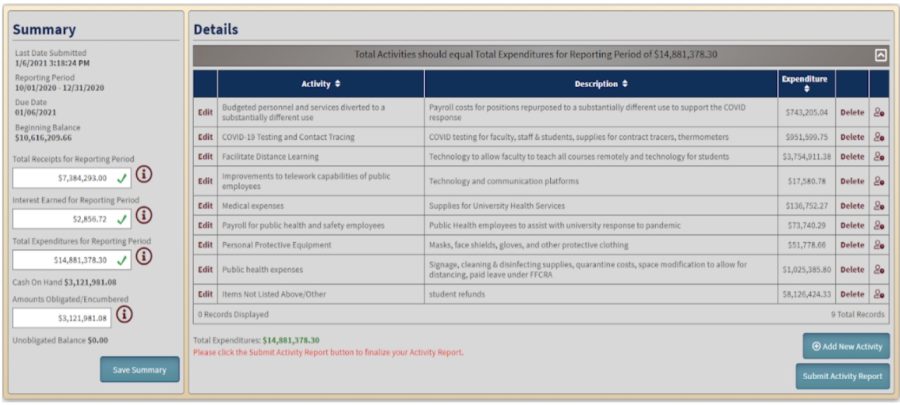How Kent State spent CARES Act funding: technology and COVID-19 protections
March 24, 2021
When Kent State received $19 million from the federal Coronavirus Aid, Relief, and Economic Security Act, or CARES Act, in 2020, at least half of that money was distributed to aid students through the pandemic.
The university put the remaining funds toward COVID-19 testing, staffing needs, cleaning supplies, distributing course lab materials to off-campus students and COVID-19-friendly HVAC modifications.
“We have invested in a technology called needlepoint bipolar ionization that distributes charged ions into the air stream that kill the COVID-19 virus,” said Doug Pearson, associate vice president of Facilities Planning and Operations.
The technology is used by many organizations, including the Cleveland Clinic, making the university “confident the technology is helping us keep the spaces clean,” Pearson said. The university bought around 250 custom portable units and currently has 40 in stock ready to be used on a case-by-case or as-needed basis, he said.
“Those are the units that we took out to the residence hall rooms that we want to treat,” Pearson said. “All you have to do is plug it into a wall. It’s got a little switch on it. You turn it on and you leave it on, and it puts the charged ions into the air stream in the residence hall.”
Kent State places units in common spaces and areas where “student activity was necessary,” including dining halls, elevators, locker rooms and dorms housing COVID-19-positive students, such as Van Campen and Verder, he said. Units can also be found in spaces such as the Student Recreation and Wellness Center and the Student Center.
“We continue to look for opportunities to implement that technology in order to fight the spread of COVID-19 and keep those students that come to campus safe,” Pearson said.
Funding from the CARES Act was also put toward COVID-19 testing efforts and staffing, said Jeannie Reifsnyder, senior associate vice president of Finance and Administration.
“There was actually quite a bit of money spent on testing and the volume of testing we did,” Reifsnyder said. “There also was some money spent on additional medical supplies and equipment for the DeWeese Health Center. … And they also did hire some additional staffing as well, some nurses.”
Some of the additional staff hired include contact tracers who worked with medical staff at Kent State to determine points of contact for those who had tested positive or needed to quarantine, she said.
The university also used a portion of the funding for reimbursement, after refunding students after the spring 2020 closure of campus.
“The grant funding also allowed us to reimburse ourselves for refunds that we gave to students for housing and dining,” Reifsnyder said. “So because we were not able to have students on campus for the full amount of time, we were giving, calculating and giving, prorated refunds to students.”
Kent State is required to report use of funding to the federal and state governments to ensure funding is distributed correctly. Funding from the CARES Act was “really important” to the university’s operations, Reifsnyder said.
“It’s important to note that there was a lot of financial impact from the pandemic on the university,” she said, “and so the funding that we received from the federal and state level was really important to be able to have us continue to operate and provide everything to the students to be able to have some activity on campus.”
Emma Andrus covers administration. Contact her at [email protected].












